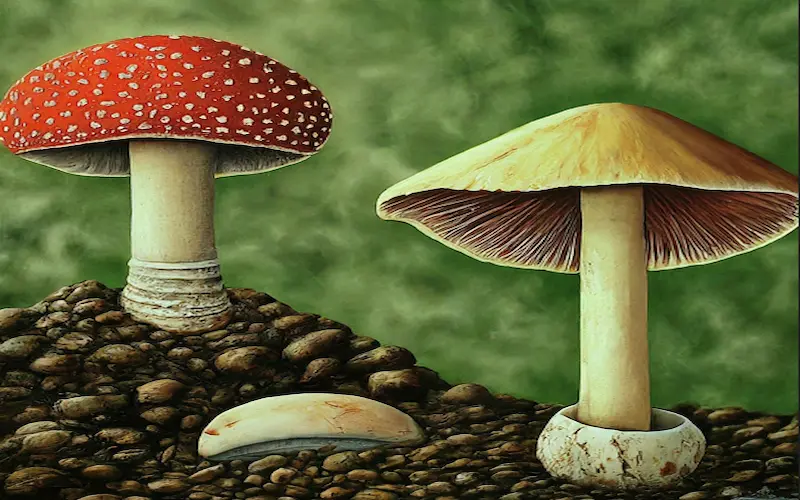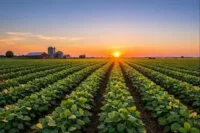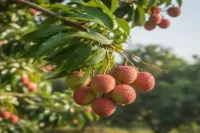The Life Cycle of a Mushroom: A Comprehensive Guide
Published: 14 Mar 2024
Mushrooms belong to the fungi kingdom, not the vegetable kingdom. They pop up in lawns and forests overnight, creating magical landscapes reminiscent of fairy tales. In this comprehensive guide, I will explain the life cycle of a mushroom, including spore germination, mycelium growth, mushroom formation, maturation, and spore dispersal.

Introduction to The Life Cycle of a Mushroom
Mushrooms undergo a unique and complex life cycle markedly different from plants and animals. This cycle includes spore germination, mycelium growth, mushroom formation, maturation, and spore dispersal. Each of these stages is critical to the continuation of a mushroom species, and the failure of any stage can halt the cycle entirely.
A mushroom’s journey begins with a single spore and can end with the production of millions more, ensuring the species’ survival and proliferation. This cycle is not just a linear progression but a cyclical process, with each end heralding a new beginning. It’s a testament to fungi’s resilience and adaptability.
Understanding these stages is fascinating from a biological standpoint and essential for those interested in mushroom cultivation. Cultivators can improve yields and grow healthier, more robust mushrooms by manipulating and optimizing conditions for each stage.

Spore Germination
The Initial Spark of Life
The mushroom life cycle ignites with the smallest of sparks: spore germination. Spores, often produced in the millions, are the reproductive units of fungi analogous to seeds in the plant kingdom. They are microscopic and can travel great distances on the wind, by water, or via animal vectors, seeking a suitable substrate to begin their life.

A Game of Chance and Survival
For a spore to germinate, it must land in a hospitable environment, which often means a moist and nutrient-rich substrate. The chances of any single spore surviving are slim, but because mushrooms produce such an astronomical number of spores, some are bound to find the right conditions. Once a spore settles in a favourable spot, it absorbs water and nutrients, and if conditions are just right, it will germinate, giving rise to a new organism.
The Birth of Hyphae
After germination, spores grow into single, thread-like cells called hyphae. These hyphae are the building blocks of the mushroom’s body. They secrete enzymes that break down the substrate, allowing the hypha to absorb the released nutrients. As the hyphae continue to grow and branch, they form a complex, interwoven mass known as mycelium, the next critical stage in the life of a mushroom.
Mycelium Growth
The Foundation of Fungal Life
Mycelium is the vegetative part of a fungus, consisting of a network of hyphae. It usually remains hidden from view, spreading extensively beneath the soil or within its chosen substrate. Depending on environmental conditions and the mushroom species, this growth phase can last for varying periods, ranging from days to years.

The Silent Spread
As the mycelium expands, it decomposes organic matter, absorbing nutrients and water. This unseen network is incredibly efficient and capable of covering large areas in its quest for sustenance. It’s the engine room of the mushroom where all the necessary preparations for forming fruiting bodies are conducted.
A Signal to Fruit
When conditions are optimal, the mycelium shifts to the next phase called mushroom formation. This transition is often triggered by environmental cues such as a change in temperature, light exposure, or nutrient availability. The mycelium concentrates its resources on specific points, initiating the development of primordia, the mushroom precursors.
Mushroom Formation
The Emergence of Primordia
Primordia are the first visible signs that a mushroom is forming. These tiny, knot-like structures emerge from the mycelium and are destined to develop into mature fruiting bodies. The primordia formation is a critical juncture in the mushroom life cycle and a sign that the mycelium has entered a reproductive phase.

The Growth of Fruiting Bodies
As primordia grow, they differentiate into the various parts of the mushroom, such as the cap, gills, and stem. This is the stage where mushrooms become recognizable to the casual observer. The speed at which fruiting bodies develop can vary greatly, with some mushrooms maturing in just a few hours while others take days or weeks.
A Race Against Time
The formation of fruiting bodies is a race against time and the elements. Mushrooms must develop quickly to ensure their spores are ready for dispersal. They are also vulnerable during this period as they can be affected by environmental stressors like drought, excessive moisture, or predation. Despite these challenges, the fruiting body pushes on, driven by the imperative to reproduce.
Mushroom Maturation
Reaching Full Potential
As the fruiting bodies continue to grow, they reach a stage of maturation. This is when the structures necessary for spore production are fully developed. In gilled mushrooms, for example, the underside of the cap will be lined with gills, each packed with spore-producing cells called basidia.
The Spore Factories
The basidia are the true spore factories of the mushroom. Each basidium produces spores through a process known as meiosis, which ensures genetic diversity. The spores are held on the basidia until they are mature and ready to be released into the environment. This is a critical moment in the mushroom’s life cycle, marking the culmination of the fruiting body’s purpose.
Environmental Triggers for Spore Release
Spore release is often triggered by environmental factors such as humidity, temperature, and air currents. Some mushrooms have evolved intricate mechanisms to eject their spores into the air, while others rely on external forces like raindrops or animal interactions to facilitate dispersal. Once the spores are released, they begin their journey, seeking new substrates to colonize, and the cycle begins anew.

Spore Dispersal
The Journey of a Million Spores
Spore dispersal is a numbers game. Each mature mushroom can release millions of spores, increasing the odds that at least some will find suitable conditions for germination. The spores are carried by wind, water, and animals over varying distances, sometimes travelling several miles from the parent organism.
The Role of Nature and Wildlife
Nature and wildlife play essential roles in the dispersal of mushroom spores. Animals that feed on mushrooms can transport spores over long distances in their fur or digestive tracts, depositing them in new environments. Meanwhile, natural phenomena like wind and rain can carry spores to remote locations, extending the reach of the fungus.
The Perpetuation of the Species
Spore dispersal is the final stage of the mushroom life cycle, but it is by no means the end. Each spore carries the potential to start the cycle over again, perpetuating the species. This phase ensures mushrooms’ genetic diversity and resilience, allowing them to adapt to changing environments and continue to thrive.

Factors Influencing the Mushroom Life Cycle
Environmental Conditions
The mushroom life cycle is heavily influenced by environmental conditions such as temperature, humidity, light, and the availability of nutrients. Each mushroom species has specific requirements that must be met for successful growth and reproduction. Deviations from these conditions can lead to halted growth or even death of the organism.
Genetic Factors
Genetic factors also play a significant role in a mushroom’s life cycle. A mushroom’s genetic makeup determines its characteristics, such as size, colour, and growth rate. It also influences how a mushroom responds to environmental stimuli and its ability to adapt to different habitats.
Human Impact
Human activity can significantly impact the mushroom life cycle, both positively and negatively. Pollution, deforestation, and climate change can alter habitats and disrupt the delicate balance for mushrooms to thrive. Conversely, humans can also create favourable conditions for mushrooms through cultivation and habitat restoration efforts.
Related Questions and Answers
The lifecycle of a mushroom typically involves spore germination, mycelium growth, fruiting body formation, spore release, and dispersal.
The stages of mushroom production include substrate preparation, injection, colonization, pinning, fruiting, and harvesting.
Conclusion
The life cycle of a mushroom is an awe-inspiring natural process that encapsulates the beauty and complexity of the fungal kingdom. From the initial spore germination to the final act of spore dispersal, each cycle stage is a testament to mushrooms’ adaptability and resilience. Understanding this life cycle deepens our appreciation for these organisms and enhances our ability to cultivate and protect their natural habitats.
As we conclude this journey through the mushroom life cycle, I hope you have gained a newfound respect for these extraordinary beings. May this guide inspire you to observe mushrooms more closely, cultivate them with care, or appreciate their presence in our ecosystems. The secrets of the mushroom life cycle are now unlocked, and with this knowledge, we can better coexist with these essential components of our natural world.

- Be Respectful
- Stay Relevant
- Stay Positive
- True Feedback
- Encourage Discussion
- Avoid Spamming
- No Fake News
- Don't Copy-Paste
- No Personal Attacks



- Be Respectful
- Stay Relevant
- Stay Positive
- True Feedback
- Encourage Discussion
- Avoid Spamming
- No Fake News
- Don't Copy-Paste
- No Personal Attacks



